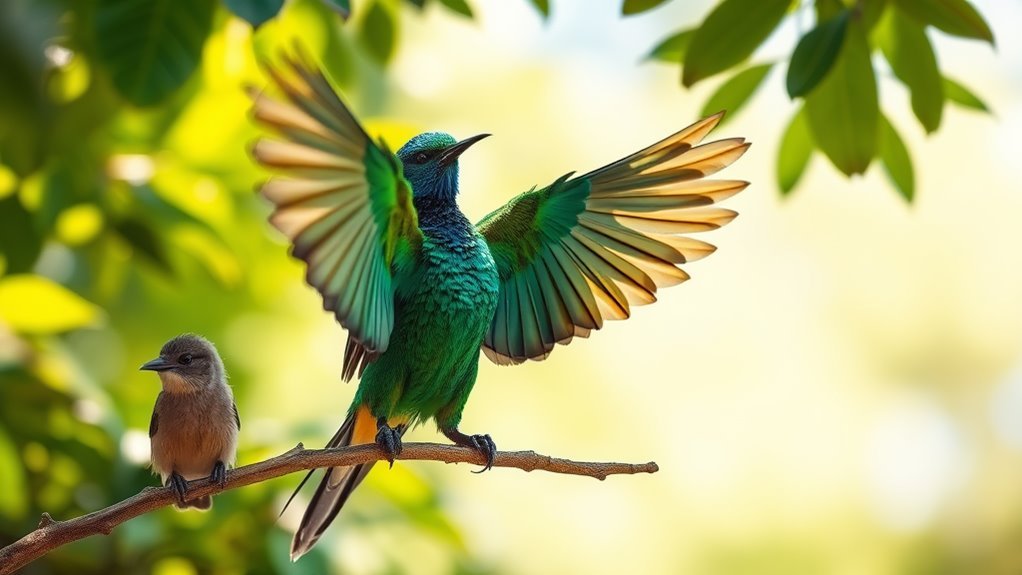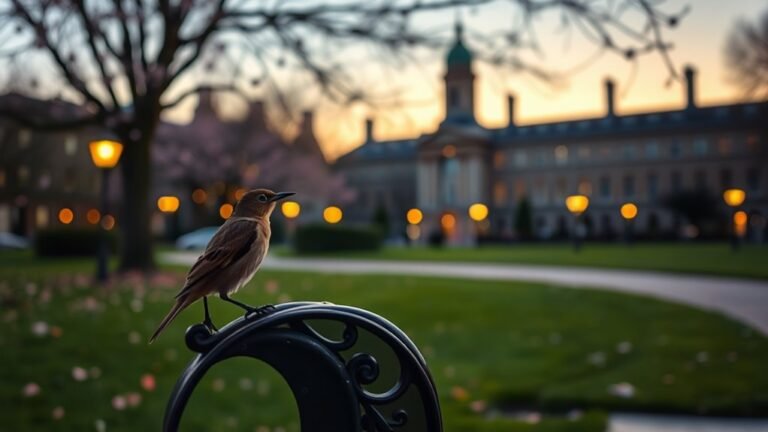The Mating Process of Birds Explained
The mating process is vital for the survival of bird species. Male birds often display colorful feathers and perform engaging courtship dances to attract female partners. Their singing helps, as these vocalizations show their health and vitality. These behaviors greatly impact their ability to reproduce and raise young. By examining their courtship methods, we can learn a lot about how bird species develop and thrive. Engaging with the beauty of these displays and sounds reveals the fascinating strategies that birds use in their mating rituals.
Key Takeaways
- Mating strategies in birds include monogamy for cooperative parenting and polygamy for maximizing genetic diversity among offspring.
- Courtship displays and vocalizations are used by males to attract mates and showcase their fitness and health.
- Nest building is essential for reproduction, with chosen materials and locations impacting the survival of eggs and chicks.
- Environmental factors like climate change and habitat loss significantly influence breeding timing and availability of resources for birds.
- Conservation efforts are vital to protect nesting sites and stabilize food sources, ensuring the successful mating and raising of future generations.
The Importance of Mating in Bird Life

Mating is vital for the survival and evolution of bird species. It serves not just to reproduce, but also to enhance genetic diversity. This diversity helps birds adapt to changes in their environment.
Birds use different mating strategies based on their habitats and competition. Some choose monogamous pairs, which allows for shared care of their young. Others may mate with multiple partners to increase gene flow.
Observing these behaviors offers insights into how species tackle challenges. For instance, the success of a species often depends on the timing of mating, which can align with food availability or environmental signals.
Understanding these mating processes highlights the connection between birds, their ecosystems, and each other, making the study of their lives intriguing and engaging.
Courtship Displays: Nature's Dance
Birds perform elaborate courtship displays to attract mates. These rituals differ among species and include bright colors, unique movements, and specific postures.
Male birds often puff up their feathers, perform aerial stunts, or engage in synchronized dances. These behaviors indicate health, fitness, and readiness to mate.
Such displays help create bonds that go beyond reproduction and foster social connections among birds. Watching these performances increases appreciation for bird life and highlights the beauty of nature and the shared need for companionship.
Vocalization and Song in Attracting Mates

Vocalizations and songs are important in the bird mating process. Birds use calls and melodies to attract mates. These songs show their variety and fitness.
Here are some key points to consider:
- Song Complexity: Intricate songs can show strength.
- Repertoire Size: A larger range of songs attracts more mates.
- Timing: Singing at the right moment improves courtship.
- Local Variation: Songs can differ by region, helping in species identification.
These factors combine to create a dynamic system of avian attraction.
Nest Building: Crafting the Perfect Home
Building a nest is an important part of a bird's reproduction. Many birds put a lot of energy and creativity into this process. They select nest materials based on what's available and suitable for their needs. Different species use various designs that reflect their characteristics.
Choosing the right location for a nest is also crucial. Birds look for places that provide protection from predators and safe environments for their young. They often prefer areas that reduce threats to their offspring.
Nest building techniques differ among species. Some birds return to the same location each year due to tradition. They also protect their territory by placing their nests in spots that deter other birds.
Each detail of nest building plays a key role in ensuring successful reproduction.
The Role of Color and Plumage in Sexual Selection

In courtship, color and plumage significantly attract mates. Birds show diverse plumage, using specific colors to indicate various traits.
Here's how color affects mate selection:
- Bright Colors: Bright colors often signal health and vitality, representing strong genetics.
- Patterns and Designs: Unique patterns can catch a mate's eye and show individuality.
- Ultraviolet Reflectance: Some birds have feathers that reflect UV light, which is visible to other birds but not to humans.
- Seasonal Changes: Many birds display vibrant plumage during breeding seasons to show they're ready to mate.
These elements show the complexity of bird courtship. Each color and feather type tells an evolutionary story, emphasizing the role of attraction in natural selection.
Monogamous vs. Polygamous Strategies
Birds have different mating strategies that help them adapt to their environments. Monogamous birds, like many songbirds, form strong pair bonds. They perform mating rituals that strengthen their relationships. This leads to cooperative parenting, which improves the chances that their young will survive.
On the other hand, polygamous birds, such as peacocks and red-winged blackbirds, mate with several partners. This strategy can increase genetic diversity, but males often need to show off superior traits to attract females.
These differing approaches highlight the ways birds strive for reproductive success and survival.
Pair Bonding: The Foundation of Avian Relationships
Successful mating strategies for birds rely on strong pair bonds. These bonds create attachment that promotes loyalty and effective resource sharing, vital for survival. Here are key aspects of avian relationships:
- Social Bonds: Birds show their connection through behaviors like preening and vocalizations.
- Territory Establishment: Strong pairs create and defend territories, which increases their chances of successful reproduction.
- Mate Selection: Males and females evaluate compatibility through displays, ensuring their offspring have genetic variation.
- Reproductive Strategies: Successful pairs often care for their young together, which helps increase the survival rate of their chicks.
Understanding these elements can enrich your appreciation for the social lives of birds.
Mating Systems: Different Approaches to Reproduction
Birds have different mating systems that show how they adapt to their environments. You might see monogamy, where one male and one female form a bond. This often leads to the pair working together to raise their young.
In contrast, polygamous systems involve a male mating with several females. This can help maximize reproductive success based on the availability of resources and competition. Some birds also participate in lekking, where males gather to display their traits, allowing females to choose the best mate.
Understanding these mating systems helps you appreciate how birds connect in their habitats. Their behaviors reflect the relationships and communities that exist in nature, much like our own social ties.
The Science of Fertilization in Birds
When a male bird copulates with a female, the process of fertilization happens inside the female's body. This process is key in bird reproduction.
Here's a simple breakdown:
- Sperm Transfer: The male bird transfers sperm to the female's cloaca during mating.
- Sperm Storage: The female can store the sperm in special glands for days or weeks. This allows her to time the fertilization of her eggs.
- Ovum Release: When she's ready, the female releases an egg into her reproductive tract.
- Fertilization: The sperm meets the egg, starting the process of fertilization and forming a zygote. This zygote will develop into a chick.
This process highlights the effectiveness and organization of bird reproduction, ensuring the continuation of their species.
Parental Investment: Nurturing the Next Generation
After fertilization, birds enter a key phase: parental investment.
Different species use various nurturing strategies to help their young survive. Often, both parents share tasks. One parent guards the nest while the other gathers food. They carefully provide resources so their young get the right nutrients for growth. Many birds feed their chicks a protein-rich diet, which is essential for muscle and feather development.
Parents also engage in brooding, keeping their chicks warm and safe. These nurturing behaviors support the immediate needs of the chicks and influence their long-term health and ability to adapt.
Through effective parental care, birds improve the likelihood of raising strong, independent young. This investment helps ensure that their lineage continues.
Challenges and Threats to Bird Reproductive Success
Birds encounter many challenges that can affect their ability to reproduce successfully. Here are some key threats to consider:
- Habitat loss – Urban development and farming destroy important nesting areas for birds.
- Predation risks – More invasive species increase the risk of predators eating bird eggs and chicks.
- Climate change – Changes in climate can disrupt breeding seasons and impact food supplies.
- Environmental pollutants – Harmful chemicals can negatively affect bird reproductive health, leading to fewer breeding successes and less genetic variety.
By understanding these threats, we can raise awareness and take action to protect bird populations.
Your involvement can make a positive impact.
Evolutionary Adaptations in Bird Mating Behaviors
Birds adapt their mating behaviors based on their environments and social groups. These adaptations help birds improve their chances of reproduction. For example, sexual dimorphism leads to noticeable physical differences between males and females. These differences help attract mates through visual signals of fitness.
Mating preferences are influenced by competition among partners. Birds often choose mates that show better genetic diversity.
Environmental factors also play a role; food availability and habitat can impact how birds display courtship behaviors.
These interactions highlight the connections between various factors, guiding the ongoing development of bird mating behaviors. Understanding these adaptations helps us appreciate the complex dance of survival and reproduction in birds.
The Future of Bird Mating Processes in a Changing World
As climate change and habitat loss affect ecosystems, bird mating processes are likely to change. These changes will reflect how birds adapt to new environments and food availability.
- Changing Breeding Times: Birds may breed earlier or later based on temperature shifts that affect food supplies.
- Social Behavior Changes: Urban settings may alter how birds display for mates and form bonds.
- Fewer Nesting Sites: More birds might find new places to nest as traditional habitats disappear.
- Increased Competition: More birds in one area can lead to new mating behaviors.
These shifts highlight the connection between adaptation and reproductive health in birds. Understanding these changes can help us protect bird populations in the future.
Frequently Asked Questions
How Do Environmental Factors Influence Bird Mating Behaviors?
Environmental factors influence bird mating behaviors significantly. Changes in habitat availability and climate can lead to altered courtship displays, nesting success rates, and mating timings. These changes show how bird species adapt to new environmental conditions. For example, when their habitat diminishes, birds may change their courtship rituals or the timing of their breeding seasons to improve their chances of success. Understanding these behaviors can help us see how birds respond to their surroundings and ensure their survival.
What Are the Risks Associated With Bird Mating?
Bird mating can come with several risks that impact their reproductive success. First, mating competition may arise, leading birds to challenge each other aggressively. These confrontations can cause injuries and drain energy, which could have been used for courtship or raising young.
Additionally, unfavorable environmental conditions, such as bad weather or lack of food, can lead to fewer viable eggs and a decrease in offspring survival. Overall, these risks can affect the long-term success of bird species. It is important for birds to navigate these challenges carefully to ensure the continuation of their lineage.
How Does Mating Season Vary Across Bird Species?
Bird mating seasons vary widely across species, with different rituals and adaptations. Some birds breed in spring. Others time their breeding with local climate conditions. This timing helps ensure successful reproduction and survival. Understanding these patterns can highlight how birds adapt to their environments and the importance of timing in nature. Each species has unique needs and behaviors that shape their mating strategies.
Can Birds Mate Outside Their Species?
Birds can mate with other birds outside their species. However, species barriers can limit successful reproduction. Sometimes, this results in hybrid offspring. These hybrids can display unique traits and behaviors. They contribute to biodiversity among birds and add interest to their lives.
What Role Do Pheromones Play in Avian Mating?
Pheromones are important for bird mating. Birds use pheromones to attract mates. These scents signal when they are ready to reproduce and indicate genetic compatibility. This helps birds form bonds that improve their chances of survival in their environment. Watch how birds interact; you will see pheromones play a key role in their mating habits.

Hello, I’m Emily Price, the founder of Birds Affection. As a passionate bird enthusiast and spiritual seeker, I’ve always been fascinated by the symbolic meanings and mystical connections between birds and our lives. On this website, I share my knowledge and insights on the spiritual significance of various bird species, exploring their roles as messengers, guides, and teachers. Through my writing, I aim to inspire and educate others on the profound wisdom and beauty that birds bring to our world. Join me on this journey as we delve into the enchanting realm of bird symbolism and discover the hidden meanings behind these magnificent creatures.







